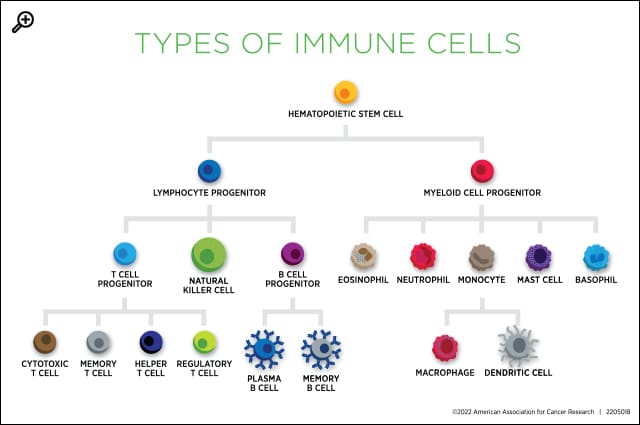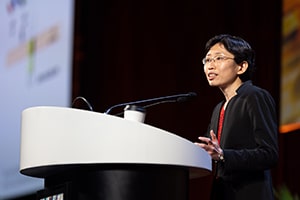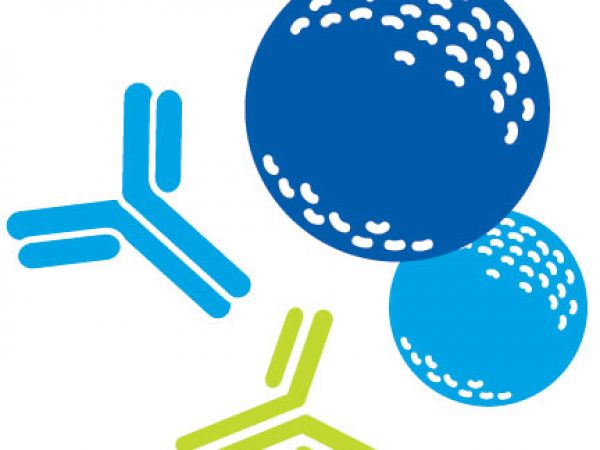Annual Meeting 2022: Natural Killer Cells and the Antitumor Immune Response
For the past several decades, researchers have been harnessing the power of the immune system to fight cancer. They have designed therapies based on antibodies and have learned how to suppress pathways that dampen T-cell responses. They have even turned the T cells themselves into therapeutics; several types of blood cancer can now be treated by harvesting a patient’s T cells, reprogramming them, and infusing them back into the patient to fight cancer.
Drawing on past successes, researchers are designing ways to manipulate another prevalent immune cell. With a name like “natural killer” (NK) cells, do these lymphocytes have a future as cancer-fighting machines?
At the AACR Annual Meeting 2022, held in New Orleans April 8-13, various researchers described the promises and challenges associated with emerging NK-cell therapies. What have scientists learned about NK cells thus far? How is that information being used to develop new therapies? Do NK cells have a future at the forefront of cellular immunotherapy?
Leveraging the Properties of NK Cells
NK cells differ from their close cousins, cytotoxic T cells, in a number of ways that influence their potential use as a cancer therapy. T cells, for example, are part of the adaptive immune system; as a population, they are designed to target a nearly infinite repertoire of molecules foreign to the human body. When a T cell encounters its target, it rapidly expands to fight the infection, a process that also promotes the production of memory T cells that can respond to future infections.
Natural killer cells, by contrast, are part of the innate immune system. Recognition of infected or cancerous cells relies on a delicate balance between activating receptors, which recognize cellular abnormalities such as viral proteins, and inhibitory receptors, which recognize “self” proteins, such as components of the MHC-I complex, on normal cells. Upon binding to a suspicious cell, natural killer cells secrete toxic granules that disrupt the outer membrane of the target cell, leading to cell death.

Michael Caligiuri, MD, FAACR, president of the City of Hope National Medical Center and Past President of the AACR, explained this process—which he called “the life of a killer”—during a Meet the Expert session. “Importantly, the NK cell remains alive itself. It doesn’t die in the process, and it’s able to recoup and continue to kill,” he emphasized.
Caligiuri went on to describe a few ways our understanding of NK cell biology could be harnessed to fight cancer. In one example, Caligiuri and colleagues found that the potent responses of NK cells to viral infection was impeding a potential viral therapy for glioblastoma.
For years, researchers have been developing oncolytic viruses—viruses that are designed to selectively infect and replicate inside a tumor cell, then kill that tumor cell and spread to others. An oncogenic herpes virus engineered to fight glioblastoma performed well in a cell culture model but had limited efficacy in animals.

Caligiuri and colleagues found that NK cells—the body’s first line of defense against herpes infections—were killing the infected tumor cells before the virus could replicate and spread. To surmount this problem, they developed an oncolytic herpes virus that expresses a negative regulator of NK cells. When the NK cells encounter a virus-infected tumor cell, the inhibitory signal essentially pauses the NK cell and prevents it from attacking, Caligiuri said. An oncolytic virus expressing the negative regulator E-cadherin significantly decreased tumor burden and improved prognosis in mice compared with an oncolytic virus without the regulator.
In many instances, however, NK cells can boost the body’s antitumor immune response. Understanding how to best leverage the effects of NK cells requires a working knowledge of the changes these cells undergo when they encounter cancer cells.
Caligiuri and colleagues found that, upon contact with a tumor, NK cells upregulate expression of the protein PD-L1. While this protein is often expressed on cancer cells to protect them from immune attack by engaging the immune checkpoint protein PD-1 on T cells, the researchers found that NK cells expressing PD-L1 were more cytotoxic than their PD-L1-negative counterparts.
The researchers further found that treating mice with atezolizumab (Tecentriq), an antibody against PD-L1, not only drove T-cell activation by blocking the immune checkpoint, but paradoxically activated PD-L1 on NK cells. This newly understood mechanism of NK cell stimulation may partially explain why some patients with PD-L1-negative tumors respond to anti-PD-L1 therapy, Caligiuri said.
“Knowing this, we can engineer tumor-reactive NK cells expressing PD-L1 and use an antibody as a switch to turn on the NK cell for further killing,” Caligiuri said.
Engineering NK Cells to Fight Cancer
An improved understanding of NK-cell biology can help researchers fine-tune therapies based on NK cells. Like T cells, researchers have long studied ways in which NK cells can be harvested, engineered, expanded, and infused into patients.
In the educational session titled “Natural Killer Cells: From Cancer Orchestrators to CAR-NK Therapy,” researchers reviewed ways that the characteristics of NK cells can be leveraged to better attack tumors. The session included a talk by Yvonne Chen, PhD, an associate professor of microbiology, immunology, and molecular genetics at the University of California, Los Angeles, about lessons learned from CAR T cells that can be applied to the design of therapeutic NK cells.
“Synthetic biology is a philosophy that biology can be an engineering-like discipline,” Chen began. “You can design a biological function by using biological building blocks.”

Chen provided several examples of how thinking about CAR engineering this way has spurred advances in CAR T-cell therapy. For example, one limitation of CAR T cells is that they require the careful selection of targets that are expressed on the cell surface and will not compromise normal tissue. Chen and colleagues are studying how to expand the applicability of CAR T cells by designing a two-step activation system. When bound by a protein on the surface of the tumor cell, these engineered cells release a cytotoxic payload that must be further activated by a different tumor-specific protein inside the cell.
The programmed release of cytotoxic molecules is a system that could easily be applied to NK cell engineering. “These basic ideas, as well as some of these engineering techniques, can be readily transferred to the context of NK cells,” Chen said. She explained that while there are biological differences between T cells and NK cells that must be accounted for when adapting these concepts, some of those cell-type specific properties may serve as advantages.
Another speaker, Katayoun Rezvani, MD, PhD, director of translational research in the Department of Stem Cell Transplantation and executive director of the adoptive cell therapy platform at The University of Texas MD Anderson Cancer Center, elaborated on how some of the NK-cell specific properties are shaping therapies in development.
One weakness of allogeneic CAR T-cell transplantation is a potentially life-threatening side effect called graft-versus-host disease (GvHD), in which the donor immune cells view the recipient’s tissues as foreign and attack them. NK cells, however, do not appear to cause GvHD and are associated with fewer adverse events overall, giving them the potential for safer allogeneic transplantation than with T cells. Rezvani explained that this is partially due to the broad library of specialized receptors NK cells use to interact with their surroundings.
“NK cells have an array of receptors on their surface that can be activating or inhibitory, which drive the endogenous ability of NK cells to recognize cancer cells or viruses,” Rezvani said. NK cells usually spare host cells by way of an inhibitory receptor that recognizes a protein complex called MHC-I, which is often downregulated in cancer cells. Because engineered CAR-NK cells also express this inhibitory receptor, they are less likely to attack healthy cells than CAR-T cells.

Rezvani and her colleagues are also leveraging these receptors to overcome another challenge of CAR cells, known as fratricide. When T or NK cells kill cancer cells, they can absorb proteins the dead cells left behind, including the target of the engineered CAR. T cells and NK cells sometimes present these target receptors on their surface, making them susceptible to killing by other CAR-expressing cells.
Rezvani and colleagues have designed NK cells that express two CARs—an activating receptor targeting the tumor cell antigen ROR1 and an inhibitory receptor targeting the NK-specific protein CS1. The CAR-NK cell kills when it encounters a tumor cell expressing the activating target, but it does not kill NK cells expressing both the activating and inhibitory targets.
Rezvani hopes that these advances in NK-cell engineering will lead to better generalizability of NK cell therapy—both in terms of the targets selected and the availability of the product. She and her colleagues are currently preparing for a clinical trial that will test the efficacy of CAR-NK cells targeting CD70, an antigen expressed on almost all cancer cells but not expressed on normal cells. The NK cells will be harvested from umbilical cord blood, making them available as an “off-the-shelf” cell therapy that can be banked and stored for future patients.
“The field of NK cells is growing,” Rezvani concluded. “As we understand more about the biology of NK cells, we can use that knowledge with the tools we have in hand to make NK cells even more potent.”
Bridging the NK-Cancer Cell Gap
NK cells, whether endogenous to the patient or infused from external sources, must find and connect with tumor cells in order to kill them. Other researchers are working to expedite that process by designing molecules that bind to both NK cells and tumor cells, bringing them together like a magnet.
“We have been generating a new platform of antibody fragments assembled together, which we call NK-cell engagers,” said Eric Vivier, DVM, PhD, a professor of immunology at Aix Marseille and chief scientific officer at Innate Pharma in France.

DVM, PhD
The system he and his colleagues developed is called ANKET—antibody-based NK-cell engager therapeutics. The first generation of ANKET molecules contain antibody-like domains specific for three different proteins: a tumor-specific antigen and two potent NK-cell activators, CD16 and NKp46. When ANKET binds to these activating receptors, it not only brings the tumor and NK cells together, but it also activates the NK cells in the process.
In a cell model of acute myeloid leukemia (AML), an ANKET targeting the tumor antigen CD123 exhibited better cytotoxic activity than an anti-CD123 antibody alone. While a phase I clinical trial of ANKET in patients with AML is ongoing, Vivier and colleagues are expanding their technology even further.
“This NK cell engager is not one molecule, but rather a platform of different molecules,” Vivier said, explaining how the domains can be changed to target different tumor molecules and different NK-cell activators. By swapping the CD123 antibody-like region for one directed toward CD19 or CD20, researchers were able to make an ANKET targeting pediatric acute lymphoblastic leukemia (ALL).
The versatility of the platform also allowed Vivier and colleagues to experiment with a tetraspecific ANKET. They added a domain that mimics the cytokine IL-2, a potent driver of NK-cell proliferation. In cells, the tetraspecific ANKET stimulated proliferation, cytotoxicity, and cytokine production better than controls lacking any one of the four domains. In a mouse tumor model, it decreased metastasis better than the trispecific ANKET.
Other researchers are taking the idea of NK-cell engagers further by attaching them to cord blood-derived NK cells prior to infusion into patients.
The group, led by Yago Nieto, MD, PhD, a professor of medicine in the Department of Stem Cell Transplantation and Cellular Therapy at The University of Texas MD Anderson Cancer Center, investigated the efficacy of this approach in a phase I clinical trial of patients with certain lymphomas. The researchers harvested NK cells from umbilical cord blood, expanded them in culture, and activated them using a special mixture of cytokines that boosts their activity.

“These cytokines give the NK cells the property of memory-like responses, with increased proliferation and cytotoxicity,” explained Rezvani, who was also involved in the study.
The activated cells are then incubated with AFM13, a bispecific antibody that recognizes CD30 on lymphoma cells and CD16A on NK cells. Because the engager is already bound to the NK cells when it enters the body, it can more easily bring the cancer and NK cells together, Nieto said.
Nieto presented preliminary results of this trial in the clinical trial plenary session titled “Clinical Trials of Cellular Immunotherapies.” Two courses of treatment have been given to 22 patients thus far, 13 of whom were treated at the recommended phase II dose. The response rate for those 13 patients was 100 percent, consisting of eight complete responses and five partial responses.
“We hope that this new therapeutic option can potentially be used as a bridge to stem cell transplantation or perhaps even as a curative treatment and will bring hope to this patient population with a large unmet need,” Nieto said in a press release about the study.



